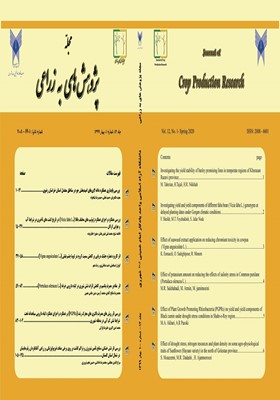Investigating the yield stability of barley promising lines in temperate regions of Khorasan Razavi province
Subject Areas : Crop Production Researchmajid taherian 1 , hamid tajala 2 , hamidreza nikkhah 3
1 - استادیار پژوهش مرکز تحقیقات کشاورزی و منابع طبیعی خراسان رضوی، سازمان تحقیقات، آموزش و ترویج کشاورزی، ایران
2 - محقق مرکز تحقیقات کشاورزی و منابع طبیعی خراسان رضوی، سازمان تحقیقات، آموزش و ترویج کشاورزی، ایران
3 - استادیار پژوهش مؤسسه تحقیقات اصلاح و تهیه نهال و بذر، سازمان تحقیقات، آموزش و ترویج کشاورزی، کرج، ایران
Keywords: Seed yield, barley, AMMI model, Genotype×Environment, Interaction effects,
Abstract :
The objective of this study was to evaluate genotypes (G), environments (E) and toanalyze genotype by environment (GE) interactions on the seed yield of 20 barleypromising lines by the additive main effects and multiplicative interaction(AMMI) model.The trials were conducted at two research stations (Neyshabur and Torogh Mashhad) fortwo successive years (2015-2017). The result’s of AMMI analysis for seed yield indicatedthat the Genotype main effects, environment, and GE interactions as well as two firstinteraction principal components (IPCA1-2) were significant. AMMI biplot was able todistinguish stable genotypes and environments with high and low genotype discriminationability. The genotypes 1 and 10 with higher mean yield than total mean were to be moststable genotypes, while the genotype 19 and 2 with the highest contribution to GEinteraction, were to be the most instable. The result of recommended genotypes based onAMMI analysis showed that the genotypes 18, 9 and 1 were highly adapted to Mashhadand genotype 20 was adapted to Neishabour environments during this study.
_||_


